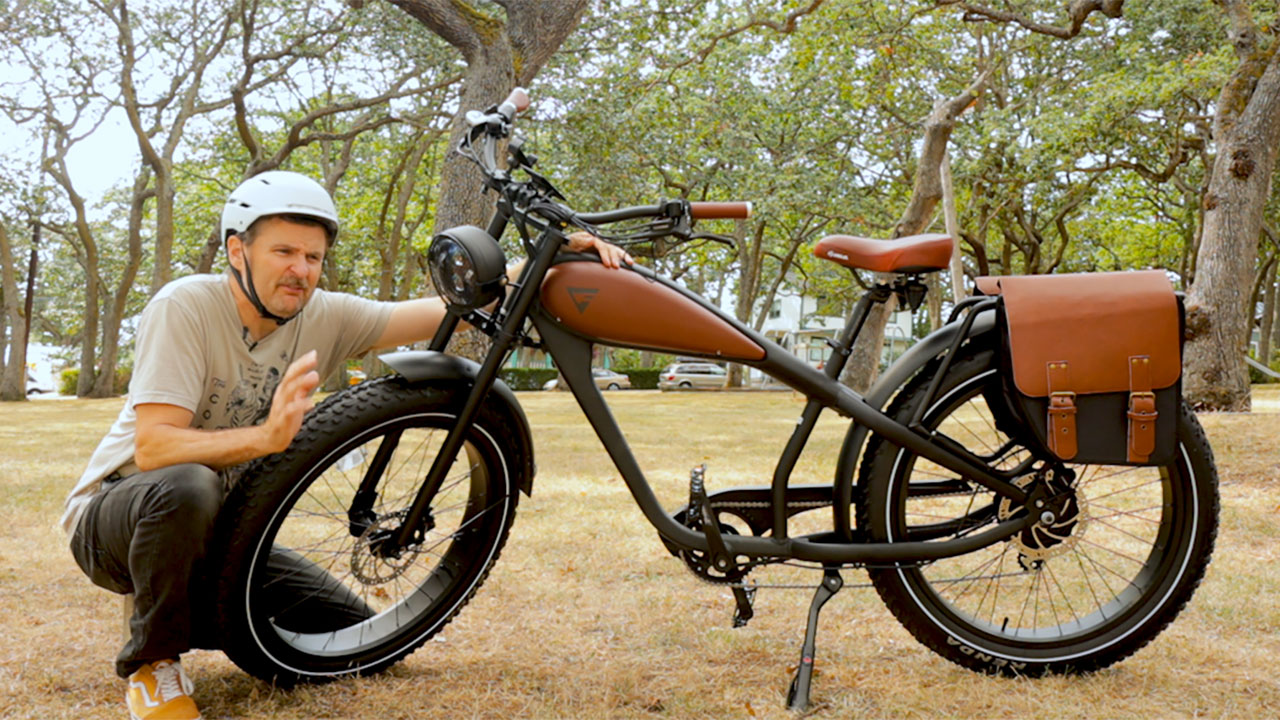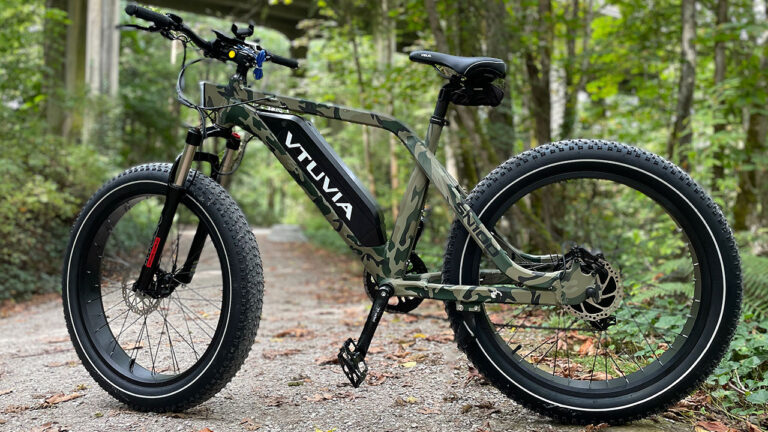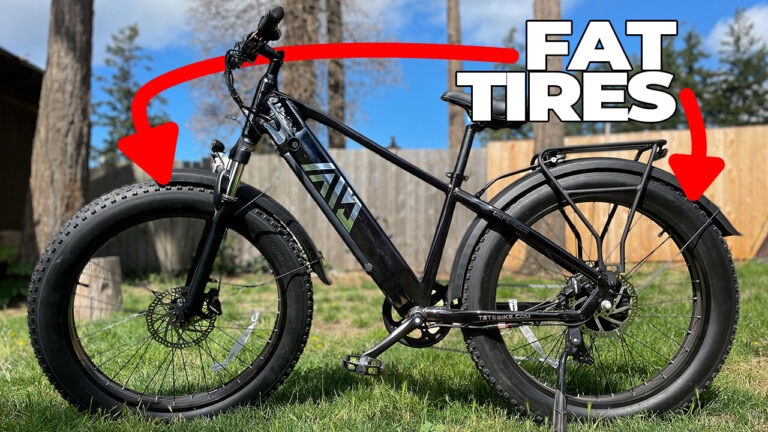If you’re searching for a unique, eye-catching e-bike that combines vintage style with modern performance, the Revibikes Cheetah Plus might just be… the bike of your dreams. And, that’s not just hyperbole, in this Revibikes Cheetah review, we’ll take a closer look at what makes this model stand out in the world of vintage and moped-style electric bikes.
First Impressions of the Revibikes Cheetah Plus
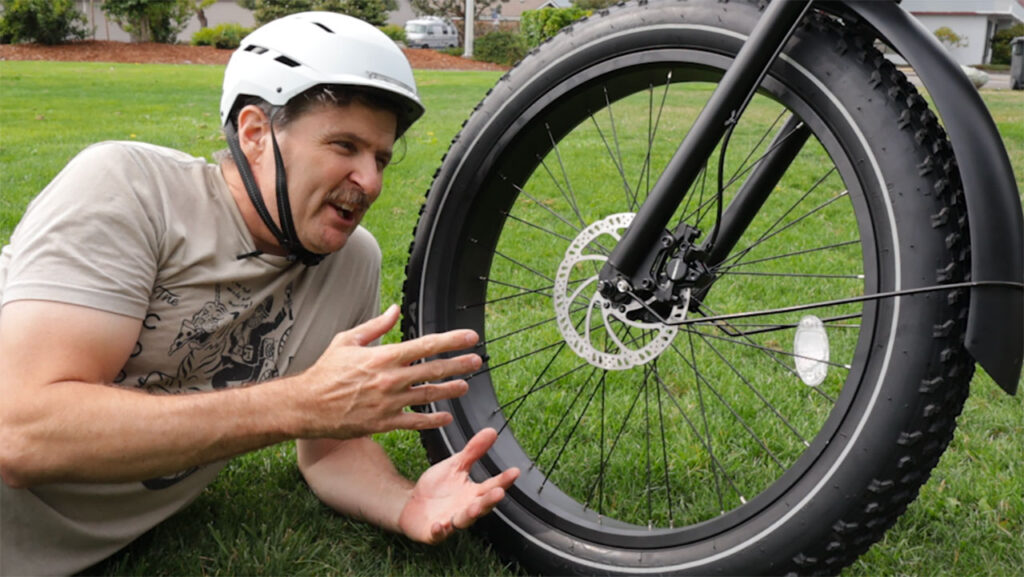
The first thing you’ll notice about the Revibikes Cheetah Plus is its striking vintage aesthetic. Inspired by classic motorcycles and café racers, the Cheetah’s design turns heads with its unique retro style. From its leather-wrapped tank cover to the moto-style headlight and hefty 26×4-inch fat tires, the Revibikes Cheetah combines old-school charm with new-age engineering.
The model I reviewed also came with Revibikes’ $250 rack and fender bundle and optional $130 saddlebags, which add both function and a touch of rugged elegance. For anyone looking to carry gear on their adventures, these add-ons could be essential.
Who Is the Revibikes Cheetah Plus For?

The Revibikes Cheetah+ appeals to riders who prioritize aesthetics and quality in their ride. It’s perfect for those who want to be seen showing off their toys, offering a unique and bold experience on the road. Its 1960s-inspired look gives off a rock-and-roll vibe, but it still packs enough modern tech to keep up with today’s urban and suburban landscapes. Riders who prefer an eye-catching design over cutting-edge 60V+ speeds or extreme all-terrain capabilities will appreciate this bike.
Performance and Specs of the Revibikes Cheetah Plus

Despite being a style-focused e-bike, the Revibikes Cheetah Plus doesn’t skimp on performance. The Cheetah Plus is powered by a 750W Bafang hub motor, which peaks at 1,200W, delivering a top speed of about 28 mph (though, the top speed I achieved was 26 mph). With a solid range of up to 65 miles per charge (if you’re insanely conservative), it’s well-suited for daily commutes and longer leisure rides alike.
The Revibikes Cheetah+ also features Tektro hydraulic disc brakes with 180mm rotors, a Shimano 7-speed mechanical drivetrain, and massive 26×4-inch Kenda fat tires that provide excellent stability. These tires, along with the bike’s low center of gravity and 440-pound load capacity, make the Cheetah Plus surprisingly easy to control.
Enhanced Safety Features and Accessories

Safety is a priority with the Revibikes Cheetah Plus. The hydraulic brakes include motor inhibitors to reduce stopping distance, giving you better control in unexpected situations. The Cheetah Plus also sports a 2,000-lumen LED headlight with high and low beams, a tail light, and an adjustable LCD display, all of which improve visibility and allow you to keep track of essential data like speed, battery life, and pedal-assist settings.
The Revibikes Cheetah+ also includes adjustable-height handlebars and a leather tank cover with the Revi Bikes logo, giving it a classy yet understated elegance. Plus, the included accessories, such as the rack, fenders, and saddlebags, add both utility and style.
Range Test and Real-World Performance

During my real-world range test, the Revibikes Cheetah+ performed admirably. After 15.5 miles of mixed riding conditions, the battery was still showing ample power. The bike can reportedly reach up to 65 miles on a single charge, depending on factors like terrain, rider weight, and pedal-assist mode. For daily commutes and recreational rides, this range should be more than sufficient.
Assembly and Build Quality

Out of the box, the Revibikes Cheetah Plus requires some assembly. The package includes the front tire, Kenda fat tires, 180mm disc brakes, a sturdy saddle, and several tools to help with setup. The bike’s extended frame immediately stands out—it’s noticeably longer than most e-bikes on the market. The Revibikes Cheetah has solid front forks instead of suspension forks, which may help slightly with range but sacrifices some shock absorption, meaning it’s best suited for smoother surfaces.
Ride Experience: Taking the Revibikes Cheetah to the Skate Park

One of the standout features of this Revibikes Cheetah review is the bike’s handling and control. At my local skate park, it handled surprisingly well for its size and weight. The Cheetah Plus isn’t designed for extreme stunts, but its balanced frame and fat tires provide a solid grip and a smooth ride. It’s clear that the Revibikes Cheetah was built to offer a comfortable, stylish cruising experience.
Is the Revibikes Cheetah Plus Worth It?
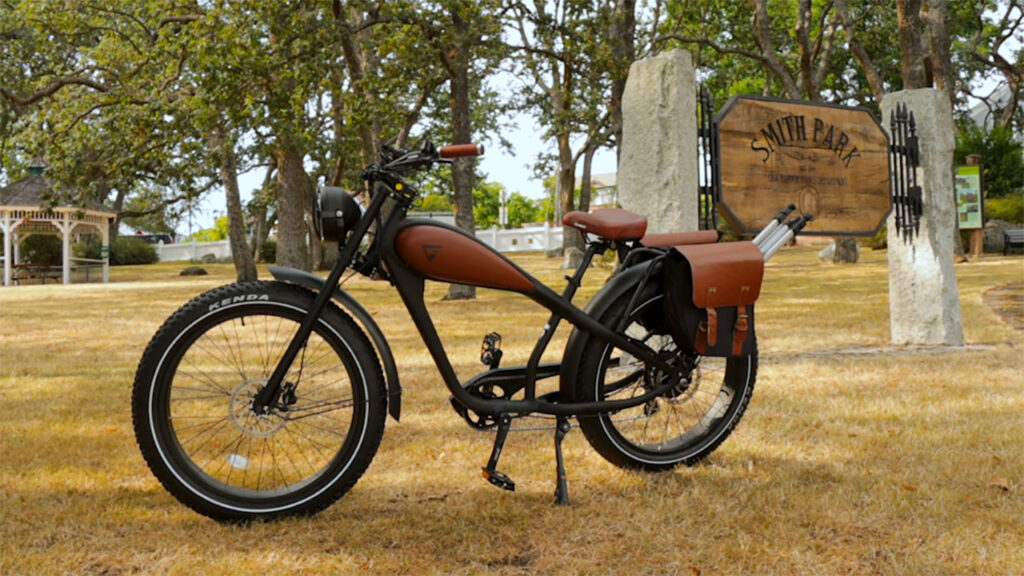
Priced at the higher end of the e-bike market, the Revibikes Cheetah Plus isn’t exactly a budget-friendly option. However, for those who value a unique design and a stylish, comfortable ride, it’s well worth the investment. It doesn’t boast extreme top speeds or off-road capabilities, but it’s perfect for riders looking for a reliable, eye-catching e-bike that adheres to class 3 e-bike regulations.
With its retro-inspired design, powerful motor, solid range, and high-quality components, the Cheetah Plus is a luxury electric bike for those who want a head-turning ride. This Revibikes Cheetah review shows that it’s not just a bike—it’s an experience, designed to make every ride memorable.
Final Thoughts

The Revibikes Cheetah Plus offers a unique blend of vintage aesthetics and modern performance. While it may be heavier and larger than some riders prefer, it makes up for it with quality, power, and style. For those who want to cruise in style without sacrificing too much in terms of power and functionality, the Revibikes Cheetah is a fantastic choice.
If you’re interested in purchasing the Revibikes Cheetah Plus, make sure to check for seasonal discounts or offers directly on the Revibikes website. It’s an investment in a unique riding experience and a stylish, head-turning e-bike that’s built to last.

